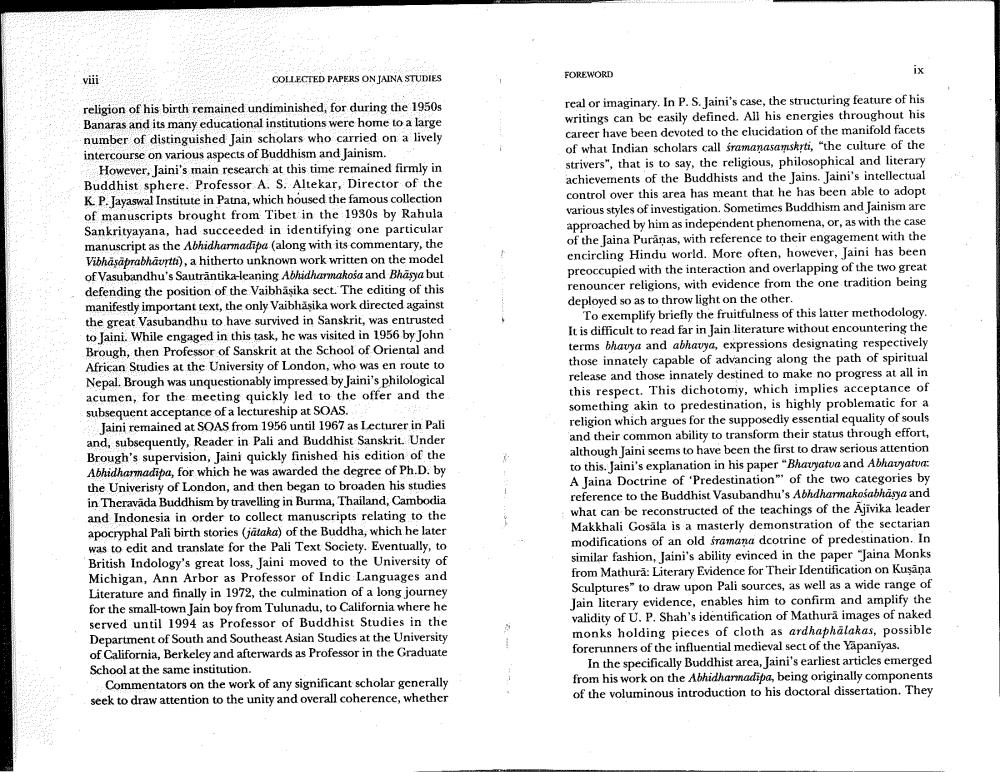________________
COLLECTED PAPERS ON JAINA STUDIES
FOREWORD
ix
religion of his birth remained undiminished, for during the 1950s Banaras and its many educational institutions were home to a large number of distinguished Jain scholars who carried on a lively intercourse on various aspects of Buddhism and Jainism.
However, Jaini's main research at this time remained firmly in Buddhist sphere. Professor A. S. Alte kar, Director of the K. P. Jayaswal Institute in Patna, which housed the famous collection of manuscripts brought from Tibet in the 1930s by Rahula Sankrityayana, had succeeded in identifying one particular manuscript as the Abhidharmadipa (along with its commentary, the Vibhasaprabhauptti), a hitherto unknown work written on the model of Vasubandhu's Sautrāntika-leaning Abhidharmakosa and Bhäsya but defending the position of the Vaibhasika sect. The editing of this manifestly important text, the only Vaibhasika work directed against the great Vasubandhu to have survived in Sanskrit, was entrusted to Jaini. While engaged in this task, he was visited in 1956 by John Brough, then Professor of Sanskrit at the School of Oriental and African Studies at the University of London, who was en route to Nepal. Brough was unquestionably impressed by Jaini's philological acumen, for the meeting quickly led to the offer and the subsequent acceptance of a lectureship at SOAS.
Jaini remained at SOAS from 1956 until 1967 as Lecturer in Pali and, subsequently, Reader in Pali and Buddhist Sanskrit. Under Brough's supervision, Jaini quickly finished his edition of the Abhidharmadipa, for which he was awarded the degree of Ph.D. by the Univeristy of London, and then began to broaden his studies in Theravada Buddhism by travelling in Burma, Thailand, Cambodia and Indonesia in order to collect manuscripts relating to the apocryphal Pali birth stories (jätaka) of the Buddha, which he later was to edit and translate for the Pali Text Society. Eventually, to British Indology's great loss, Jaini moved to the University of Michigan, Ann Arbor as Professor of Indic Languages and Literature and finally in 1972, the culmination of a long journey for the small-town Jain boy from Tulunadu, to California where he served until 1994 as Professor of Buddhist Studies in the Department of South and Southeast Asian Studies at the University of California, Berkeley and afterwards as Professor in the Graduate School at the same institution.
Commentators on the work of any significant scholar generally seek to draw attention to the unity and overall coherence, whether
real or imaginary. In P. S. Jaini's case, the structuring feature of his writings can be easily defined. All his energies throughout his career have been devoted to the elucidation of the manifold facets of what Indian scholars call framanasamskyti, "the culture of the strivers", that is to say, the religious, philosophical and literary achievements of the Buddhists and the Jains. Jaini's intellectual control over this area has meant that he has been able to adopt various styles of investigation. Sometimes Buddhism and Jainism are approached by him as independent phenomena, or, as with the case of the Jaina Puranas, with reference to their engagement with the encircling Hindu world. More often, however, Jaini has been preoccupied with the interaction and overlapping of the two great renouncer religions, with evidence from the one tradition being deployed so as to throw light on the other.
To exemplify briefly the fruitfulness of this latter methodology. It is difficult to read far in Jain literature without encountering the terms bhavya and abhavya, expressions designating respectively those innately capable of advancing along the path of spiritual release and those innately destined to make no progress at all in this respect. This dichotomy, which implies acceptance of something akin to predestination, is highly problematic for a religion which argues for the supposedly essential equality of souls and their common ability to transform their status through effort, although Jaini seems to have been the first to draw serious attention to this. Jaini's explanation in his paper "Bhavyatua and Abhavyatua: A Jaina Doctrine of 'Predestination of the two categories by reference to the Buddhist Vasubandhu's Abhdharmakośabhâsya and what can be reconstructed of the teachings of the Ajivika leader Makkhali Gosāla is a masterly demonstration of the sectarian modifications of an old śramana dcotrine of predestination. In similar fashion, Jaini's ability evinced in the paper "Jaina Monks from Mathura: Literary Evidence for Their Identification on Kusana Sculptures to draw upon Pali sources, as well as a wide range of Jain literary evidence, enables him to confirm and amplify the validity of U. P. Shah's identification of Mathură images of naked monks holding pieces of cloth as ardhaphalakas, possible forerunners of the influential medieval sect of the Yapaniyas.
In the specifically Buddhist area, Jaini's earliest articles emerged from his work on the Abhidharmadipa, being originally components of the voluminous introduction to his doctoral dissertation. They




